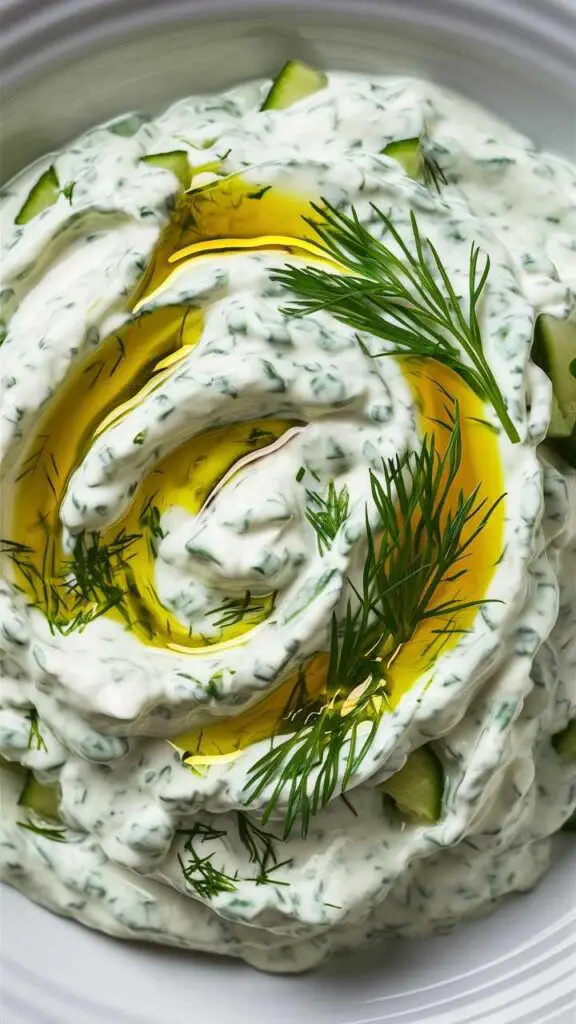If you’re a fan of Mediterranean cuisine, chances are you’ve encountered the tantalizing Greek tzatziki sauce. This creamy, yogurt-based condiment is a staple in Greek kitchens and restaurants, adding a burst of flavor and freshness to a variety of dishes. As an experienced food blogger and professional cook, I’ve had the pleasure of indulging in authentic tzatziki sauce during my travels and have mastered the art of recreating this delectable treat at home.
Ingredients
To prepare a batch of authentic Greek tzatziki sauce, you’ll need:
- 2 cups of plain Greek yogurt (full-fat or low-fat)
- 1 large cucumber, grated or finely diced (approximately 1 1/2 cups)
- 3-4 cloves of garlic, minced or grated
- 2 tablespoons of fresh dill, finely chopped (or 1 tablespoon dried dill)
- 2 tablespoons of fresh lemon juice (approximately 1 small lemon)
- 2 tablespoons of extra virgin olive oil
- 1 teaspoon of white vinegar (optional)
- 1/2 teaspoon of salt (or to taste)
- 1/4 teaspoon of freshly ground black pepper (or to taste)
Timing
- Preparation Time: 20 minutes
- Cooking Time: 0 minutes
- Total Time: 20 minutes (plus chilling time)
Step-by-Step Guide to Making Greek Tzatziki Sauce
Step 1- Prepare the Cucumber: Peel the cucumber (optional) and grate or finely dice it into small pieces. Transfer the grated or diced cucumber to a colander or fine-mesh sieve and sprinkle with a pinch of salt. Allow it to sit for 10-15 minutes to release excess moisture, then gently squeeze or press the cucumber to remove as much liquid as possible.
Step 2- Mix the Yogurt Base: In a large mixing bowl, combine the Greek yogurt, minced garlic, fresh dill (or dried dill), lemon juice, olive oil, vinegar (if using), salt, and black pepper. Whisk the ingredients together until well-blended.
Step 3- Incorporate the Cucumber: Gently fold the drained and squeezed cucumber into the yogurt mixture, ensuring it is evenly distributed throughout the sauce.
Step 4- Chill and Serve: Cover the tzatziki sauce with plastic wrap or transfer it to an airtight container and refrigerate for at least 30 minutes to allow the flavors to meld. This step is crucial as it allows the sauce to thicken and develop its signature tangy taste. Once chilled, give the sauce a gentle stir and adjust the seasoning if needed. Serve chilled, garnished with a drizzle of olive oil and a sprinkle of fresh dill or mint (optional).

Tips for Choosing the Best Yogurt for Tzatziki Sauce
The quality of the yogurt you choose plays a crucial role in the overall texture and flavor of your tzatziki sauce. Here are some tips to help you select the best yogurt:
-
Greek Yogurt: Opt for plain, full-fat Greek yogurt, which is thicker and creamier than regular yogurt due to the straining process it undergoes. This thickness helps create a rich, velvety texture in your tzatziki sauce.
-
Strained Yogurt: If Greek yogurt is unavailable, you can use regular plain yogurt and strain it through a cheesecloth or a fine-mesh sieve to remove excess liquid, resulting in a thicker consistency.
-
Avoid Low-Fat or Non-Fat Yogurt: While these options may seem healthier, they often lack the richness and creaminess that full-fat yogurt provides, leading to a watery or lackluster tzatziki sauce.
How to Properly Prepare and Strain Cucumbers for Tzatziki Sauce
The cucumber is a key ingredient in tzatziki sauce, providing a refreshing crunch and a subtle sweetness. However, if not properly prepared, it can release excess moisture, resulting in a watery sauce. Follow these steps to ensure your cucumbers are perfectly prepped:
-
Peel or Not to Peel: While some recipes call for peeling the cucumber, it’s a matter of personal preference. Leaving the skin on adds texture and a vibrant green color to the sauce.
-
Seed or Not to Seed: If using a large, seeded cucumber, consider removing the seeds to prevent excess moisture and a bitter taste. For seedless or English cucumbers, this step is unnecessary.
-
Grate or Dice: You can either grate the cucumber using a box grater or finely dice it into small cubes. Grating releases more moisture, while dicing retains a crunchy texture.
-
Salt and Strain: After grating or dicing the cucumber, sprinkle it with a pinch of salt and let it sit for 10-15 minutes. This process helps draw out excess moisture. Then, using a cheesecloth or a fine-mesh sieve, gently squeeze or press the cucumber to remove as much liquid as possible.
Adding the Perfect Herbs and Seasonings to Tzatziki Sauce
While the combination of yogurt, cucumber, and garlic forms the base of tzatziki sauce, the addition of fresh herbs and seasonings takes it to new heights of flavor. Here are some popular options to consider:
-
Dill: Fresh dill is a classic herb used in traditional tzatziki sauce, lending a distinct, slightly anise-like aroma and flavor. If using dried dill, adjust the quantity accordingly, as dried herbs are more potent.
-
Mint: While not as common as dill, fresh mint adds a refreshing, cooling note to the sauce, complementing the tangy yogurt and cucumber flavors beautifully.
-
Lemon Juice: A squeeze of fresh lemon juice brightens up the sauce, balancing the richness of the yogurt and adding a subtle citrusy tang.
-
Vinegar: A splash of white vinegar or red wine vinegar can enhance the tanginess of the sauce, mimicking the traditional Greek flavor profile.
-
Garlic: Adjust the amount of garlic to suit your taste preferences. Some prefer a subtle garlic presence, while others enjoy a more robust, pungent flavor.
-
Salt and Pepper: Don’t forget to season your tzatziki sauce with salt and freshly ground black pepper to balance and enhance the flavors.
Serving Suggestions for Greek Tzatziki Sauce
The versatility of Greek tzatziki sauce is one of its greatest assets. This cool and creamy condiment can be enjoyed in a variety of ways, adding a burst of flavor to both traditional Greek dishes and modern culinary creations. Here are some serving suggestions to inspire you:
-
Mezze Platter: Serve tzatziki sauce as part of a Mediterranean mezze platter, accompanied by warm pita bread, crisp vegetables, olives, and other dips like hummus or baba ghanoush.
-
Gyros and Souvlaki: Tzatziki sauce is the perfect accompaniment to traditional Greek gyros and souvlaki (grilled meat skewers). Drizzle it generously over the meat and wrap it in warm pita bread for a delightful handheld meal.
-
Grilled Meats and Vegetables: Use tzatziki sauce as a cooling and flavorful topping for grilled chicken, lamb, or fish. It also pairs beautifully with grilled vegetables like zucchini, eggplant, and bell peppers.
-
Salads: Drizzle tzatziki sauce over Greek salads or use it as a dressing for crisp cucumber or tomato salads, adding a refreshing and creamy element.
-
Sandwiches and Wraps: Spread tzatziki sauce on pita bread, wraps, or sandwiches for a tangy and refreshing twist on your favorite fillings.
-
Dipping Sauce: Serve tzatziki sauce as a dip for fresh vegetables, pita chips, or breadsticks for a healthy and flavorful snack.

Common Mistakes to Avoid When Making Tzatziki Sauce
While tzatziki sauce may seem straightforward to prepare, there are a few common pitfalls to be aware of to ensure a perfectly creamy and flavorful result:
-
Not Draining the Cucumber Properly: Failing to adequately drain the cucumber can result in a watery, diluted sauce. Be sure to follow the salting and straining steps to remove excess moisture.
-
Using Low-Quality Yogurt: Opt for high-quality, full-fat Greek yogurt or properly strained regular yogurt to achieve the desired thick and creamy texture.
-
Over-Mincing the Garlic: While garlic is a key ingredient, over-mincing or over-processing it can lead to a harsh, overpowering flavor. Aim for a fine mince or grate to distribute the garlic evenly throughout the sauce.
-
Skimping on Fresh Herbs: Fresh herbs like dill and mint are essential for imparting authentic Greek flavors. Don’t be tempted to substitute with dried herbs or omit them altogether.
-
Rushing the Chilling Process: Allowing the tzatziki sauce to chill for at least 30 minutes is crucial for the flavors to meld and the texture to thicken properly. Resist the temptation to serve it immediately after mixing.
Health Benefits of Homemade Greek Tzatziki Sauce
In addition to being a flavorful and versatile condiment, homemade Greek tzatziki sauce also offers several health benefits. Here’s why you should consider incorporating this delightful sauce into your diet:
-
Nutrient-Dense Ingredients: Tzatziki sauce is made with nutrient-rich ingredients like Greek yogurt, cucumbers, garlic, and olive oil, providing a range of vitamins, minerals, and beneficial compounds.
-
Probiotic Powerhouse: Greek yogurt is a rich source of probiotics, which are beneficial bacteria that support gut health and immune function.
-
Low in Calories and Fat: When made with low-fat or non-fat Greek yogurt, tzatziki sauce is a low-calorie and low-fat option, making it a guilt-free addition to your meals.
-
Hydrating Properties: Cucumbers are high in water content, contributing to the hydrating qualities of tzatziki sauce, which can be particularly refreshing during the warmer months.
-
Anti-Inflammatory Benefits: Garlic and olive oil, both key ingredients in tzatziki sauce, are known for their anti-inflammatory properties, which can help reduce the risk of chronic diseases.
Nutritional Facts
Based on a 2-tablespoon serving):
- Calories: 60
- Total Fat: 4g
- Saturated Fat: 1g
- Cholesterol: 5mg
- Sodium: 120mg
- Total Carbohydrates: 3g
- Dietary Fiber: 1g
- Sugars: 2g
- Protein: 3g
Please note that these values may vary depending on the specific ingredients and quantities used in your recipe.
Conclusion
Greek tzatziki sauce is a culinary gem that deserves a place in every home cook’s repertoire. Its refreshing, tangy flavors and versatility make it a perfect accompaniment to a wide range of dishes, from traditional Greek fare to modern fusion creations. By following the step-by-step guide and tips provided in this article, you can confidently recreate this beloved sauce in your own kitchen, impressing your guests and elevating your meals to new heights of flavor.
Remember, the key to a successful tzatziki sauce lies in the quality of the ingredients, proper preparation techniques, and allowing the flavors to meld during the chilling process. With a little patience and attention to detail, you’ll be rewarded with a creamy, zesty sauce that will transport your taste buds to the sun-drenched shores of Greece.
FAQs
Can I use regular yogurt instead of Greek yogurt?
While Greek yogurt is preferred for its thick and creamy texture, you can substitute regular plain yogurt. However, you’ll need to strain it through a cheesecloth or a fine-mesh sieve to remove excess liquid and achieve a thicker consistency.
Can I use dried herbs instead of fresh herbs?
Fresh herbs like dill and mint are highly recommended for their vibrant flavors and authentic taste. However, if you don’t have access to fresh herbs, you can use dried herbs as a substitute, but adjust the quantities accordingly, as dried herbs are more potent.
Can I make tzatziki sauce ahead of time?
Yes, tzatziki sauce can be made ahead of time and stored in an airtight container in the refrigerator for up to 3-4 days. However, it’s best to let it chill for at least 30 minutes before serving to allow the flavors to meld and the texture to thicken properly.
Can I freeze tzatziki sauce?
While it’s possible to freeze tzatziki sauce, the texture and consistency may change upon thawing. The cucumber and yogurt may release excess moisture, resulting in a slightly watery sauce. If you plan to freeze it, it’s best to consume it within 2-3 months for optimal quality.
Can I use tzatziki sauce as a salad dressing?
Absolutely! Tzatziki sauce makes an excellent salad dressing, especially for Greek or Mediterranean-inspired salads. Simply thin it out with a little water or lemon juice to achieve the desired consistency, and drizzle it over your favorite greens and vegetables.
Can I add other herbs or spices to tzatziki sauce?
While the traditional tzatziki sauce recipe calls for dill and/or mint, you can experiment with other fresh herbs like parsley, chives, or even a pinch of cumin or paprika for a unique twist. Just be mindful not to overpower the delicate flavors of the sauce.
How long does tzatziki sauce last in the refrigerator?
Properly stored in an airtight container, homemade tzatziki sauce will typically last for 3-4 days in the refrigerator. However, it’s best to consume it within that timeframe for optimal freshness and flavor.
Remember, these are general guidelines, and your personal taste preferences may vary. Feel free to adjust the ingredients and seasonings to suit your palate, and don’t hesitate to experiment with different serving suggestions to discover new and exciting ways to enjoy this versatile Greek sauce.
